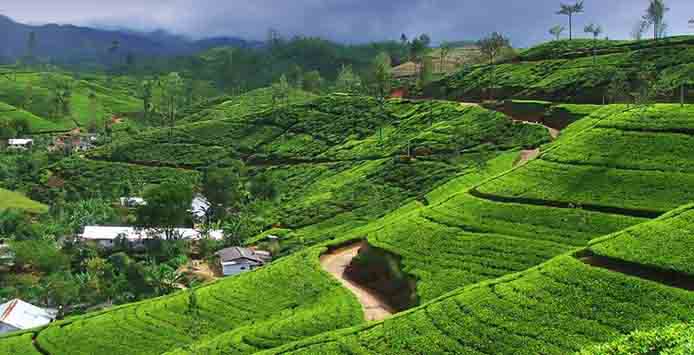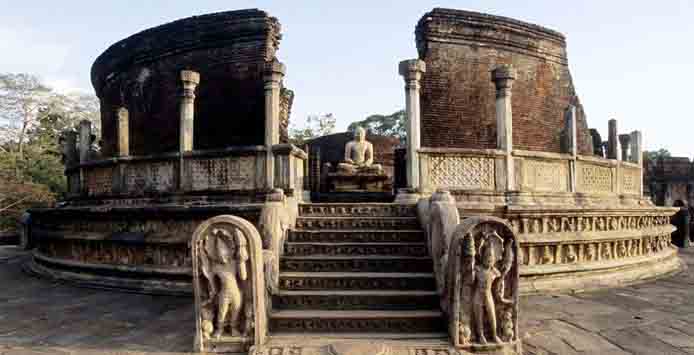About Sri Lanka
Sri Lanka is an island nation located in the Indian Ocean, just off the southeastern coast of India. Despite its modest size – slightly larger than the state of West Virginia – Sri Lanka has a population of about 20 million people, almost equal to the population of Texas. The island is rich in natural resources, and has a diverse economy based on agriculture, mining, fishing, manufacturing, and tourism. On becoming an independent nation in 1948 Sri Lanka (formerly called Ceylon) seemed to be headed for a future as a stable and prosperous democracy. Since the 1970s, however, the country has been torn by violent struggles between the two main ethnic groups, Sinhalese and Tamils, that make up its population.
Geography
Shaped like a teardrop, the island of Sri Lanka measures about 255 miles (415 km.) from north to south, and about 135 miles (220 km.) from east to west, with a total land area of about 25,300 square miles (65,600 square km.). It has more than 830 miles (1340 km.) of coastline. The island is ringed by a broad coastal plain, rising to an inland terrain of gently rolling hills. A range of mountains dominates the south-central interior, with the highest peak, Mt. Piduruthalagala,reaching more than 8200 feet (2524 meters) in height.
Located between 5 and 10 degrees latitude north of the equator, Sri Lanka has a tropical climate dominated by two monsoon seasons. The summer monsoon lasts from mid-May to October, when winds from the southwest bring rain from the Indian Ocean to the southern and western parts of the island. During the winter monsoon, from December through March, winds from the northeast bring rain from the Bay of Bengal to northern and eastern regions. Monsoon rains are constant and heavy, with up to 100 inches of rain per month falling during the summer monsoon in the southwest. October-November and mid-March to mid-May are inter monsoon seasons, with less rainfall. The climate is hot and humid for much of the year, but is cooler in the highlands.
History
The Ancient Period About 2600 years ago, migrants from northern India, the ancestors of today's Sinhalese people, arrived in Sri Lanka. The Sinhalese were among the earliest people outside northern India to adopt the Buddhist religion, which they did around 300 B.C.E. The Buddhist kingdoms of Sri Lanka were related by language and culture to the classic states of northern India, such as the Maurya (324-187B.C.E.) and Gupta (c. 320-c.550 C.E.) empires, and were in contact with them through diplomacy and trade.
The Sri Lankan Buddhist kingdoms flourished by building and controlling irrigation networks on the plains in the northern part of the island. One ancient capital, Anuradhapura, was home to some of the largest and most impressive Buddhist temples of southern Asia. The ruler of another Sri Lankan state, King Kasyapa (r. 473-491) made his capital at Sigiriya, a natural rock fortress rising a sheer 500 feet above the surrounding plain, on top of which the king built an elegant city of palaces and gardens.
King Kysapa and other Sri Lankan kings had to deal with occasional invasions from Tamil Nadu, in southern India, which increased in frequency and severity after around 600 C.E. Sri Lanka struggled, not always successfully, to remain independent of the great chole Empire that dominated southern India from about 850 to 1279 C.E. A Tamil kingdom was established on the Jaffa Peninsula, in the northern part of Sri Lanka, by the early 13th century. Meanwhile the center of Sinhalese royal power drifted steadily toward the southern and western parts of the island, and the separate Sinhalese kingdom of Kandy rose to power in the central hills. The division of Sri Lanka into a Tamil north and east, and a Sinhalese south, center and west, is thus not a new phenomenon of the 20th century, but a situation that has existed for hundreds of years.
Trade and the Colonial Era
Long-distance ocean trade in the Indian Ocean region has existed since ancient times. The Roman Empire imported luxury goods from Sri Lanka, including gemstones and cinnamon. Sri Lankan ships sailed as far west as Arabia, and as far east as China. Arab and Persian merchants knew Sri Lanka as the island of Serendib (a word that gives us "serendipity," meaning "something which comes as a pleasant surprise"). "Treasure ships" sent by the emperor of Ming Dynasty China visited Sri Lanka during the 15th century.
Sri Lanka began to feel the impact of Europe soon after Portuguese ships found their way to the Indian Ocean at the end of the 15thcentury. Because Sri Lanka was rich in goods that Europeans wanted, and also because it is a convenient place to stop on the way from Europe to Indonesia and China, Europeans competed to control the island and its trade. The Portuguese conquered Sri Lanka's coastal cities in the 16th century but faced fierce competition from the Dutch for control of the island. By 1707 the Dutch had captured the last of the Portuguese forts along the coast and became the main European power in Sri Lanka, but they in turn lost out to the British in 1795-96. By 1818 the British had also defeated the independent inland Kingdom of Kandy, and the whole island of Sri Lanka became part of the British Empire.
Under British colonial rule, the economy of Sri Lanka was transformed to become a producer of agricultural products for foreign trade. Soon the economy was dominated by plantation crops such as coffee, tea, rubber, and coconuts. The British authorities also encouraged the migration of Tamil laborers from southern India to Sri Lanka to work on the plantations. Colonial rule created new elite groups, including plantation managers, intellectuals who took advantage of the opportunity to gain a western-style education, and bureaucrats who worked for the colonial government. But ethnic problems continued to complicate Sri Lankan national life.
Independence
All over South Asia (including today's countries of India, Sri Lanka, Myanmar, Pakistan, and Bangladesh), resistance to British rule grew rapidly after the end of World War I in 1919. In Sri Lanka, which was comparatively small, stable, and well governed under British rule, the country's first democratic election was held in 1931. A movement toward economic self-determination leading to full independence was spearheaded by Sri Lanka's greatest modern leader, Don Stephen Senanayake (1884-1952). When Sri Lanka became independent on February4, 1948, Senanayake became the country's first prime minister. He committed his government to the principles of a free, democratic, and multi-ethnic Sri Lanka.
About Colombo
Colombo is the capital city and the commercial centre of Sri Lanka, filled with shopping centers and all modern facilities. The city has an eclectic blend of old and new, traditional and modern, Eastern and Western.
Colombo is a relatively easy city to find your way around. To the north is the Fort district, the country's business centre, which has department stores, book shops, airline offices and is the site of the Central Bank. There are also ample sights such as the clock tower, a former lighthouse, the president's residence (known by incorrigible traditionalists as Queen's House), and a cluster of colonial buildings which lend the district an aura of bygone Empire.
Immediately south of here is Galle Face Green, a seafront expanse of occasional green graced by cricket games, kite flyers and trusting lovers. Cinnamon Gardens, further south, is Colombo's most fashionable neighborhood, with elegant mansions, tree-lined streets and the city's largest park. East of the fort is the pungent Pettah bazaar district. Walk through and marvel at the riot of goods - fruit, vegetables, meat, gems, gold, silver, brass and tin junk.
Culture buffs shouldn't miss the National Museum, which has a good collection of historical works, the Art Gallery, which focuses on portraiture and temporary exhibits by local artists, and the city's many mosques and Buddhist and Hindu temples. After familiarizing yourself with Sri Lankan culture, check out the island's fauna at the Dehiwala Zoo. The highlight here is an afternoon elephant show. The closest real beach is at Mt Lavinia, a faded resort 10km south of the city. Budget accommodation, cheap food and the best shopping can be found in the Fort and Pettah districts. Nightlife is moribund, though a visit to the cinema in the Fort district is an experience.
Contact Details
| Head Office | |||||||||||||||
| Explore Vacations |
|||||||||||||||
| No. 371/5, Negombo Road, Seeduwa, Sri Lanka. |
|||||||||||||||
|
|||||||||||||||
| e-mail info@lankahotelbooking.com sales@explorevacations.lk |
|||||||||||||||
| web www.lankahotelbooking.com www.explorevacations.lk |

| About Us | Our Services | Sri Lanka | Sri Lanka Hotels | Contact Us | |
| About us | Hotels & Accommodations | About Sri Lanka | 5 Star Hotels | All Hotels in Sri Lanka | Address: |
| Careers | Transport | Sri Lanka Attractions | Beach Hotels | Boutique Hotels | Explore Vacations |
| Contact Us | Airport Services | Sri Lanka Hotels | Bungalows & Villas | Colombo Hotels | No. 371/5, |
| Testimonials | Sri Lanka News and Events | Cultural Area Hotels | East Coast Hotels | Negombo Road, Seeduwa, | |
| Terms & Conditions | Travel Tips | Hill Country Hotels | Ayurvedic Hotels | Sri Lanka. | |
| Privacy Policy | Wildlife & Eco Hotels | Tel: 0094 114 941650 | |||
| Image Gallery | |||||
| Tour Packages: | Email: | ||||
| Hill Country Tour Packages | Leisure Tours Packages | info@lankahotelbooking.com | |||
| Adventure Tours Packages | Wellness Tours Packages | ||||
| Cultural Tours Packages | Honeymoon Tour Packages |






